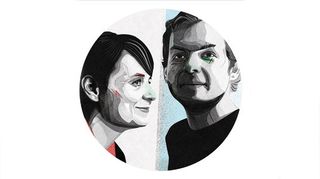Why mixing client work with education leads to innovative design
TwoPoints.Net co-founders explain how they took client work to the next level by going back to school.

Education needn't end when a design career begins. Not content with running a successful studio with an international clientele, TwoPoints.Net co-founders Martin Lorenz and Lupi Asensio also direct degree programmes and somehow find the time to study, too.
TwoPoints.Net is a small Barcelona-based design studio that likes to think big. Both Lorenz and Asensio teach post-graduate degree programmes in typography, and are also studying for their own PhDs.
As the pair reveal, combining work with study can lead to fresh opportunities and motivations to learn...
Martin Lorenz on innovation
The years we spent in education have always been our most enjoyable. We've studied design in Germany, the Netherlands and Spain, where the different teaching methods kept things interesting. No doubt sometimes I was a difficult student and perhaps a little too critical, but I always enjoyed the debates I had with teachers.
After graduation, the biggest worry was that my learning would stagnate, so I started several self-commissioned projects to create new learning environments. And even if a project was commissioned, we always tried to build in a phase that would allow us to experiment, learn and study."
I began a PhD at the University of Barcelona in 2005, and since 2007 I've been writing a dissertation about flexible visual identities. The project gives me a reason to dig deep into the history of graphic design, which I might not have done otherwise. The knowledge I've gained is routinely applied to the classes I teach at Design Werkstatt, as well as at our design studio.
The more you know about the history of design, the harder it can be to create something 'singularly original'. On the other hand, you might get inspired to follow the trajectory of someone’s work and come up with a novel synthesis. To me, that's innovation. Without knowing about the past, you can’t create something truly new.
Lupi Asensio on design as architecture
When we started our PhDs we realised how difficult it was for us to write compared to other students involved in theoretical studies. Our main communication tool is the visual and not the written language. Yet it makes a lot of sense that designers are investigating this avenue.
I always thought it strange that design history is often written by art historians. Of course, they can talk about facts and context, but design is about making projects and in this sense it's closer to architecture than to art. Some people (at least in Spain) do research to get a job in an academic institution, but we already have a job: we are designers and we love what we do and we want to continue to do it.
This means we don't have much time to dedicate to research, but it allows for a different point of view because you're writing what you're doing every day.
Teaching is also one of my passions. Since 2005 I've been teaching, and since 2007 I've been a director of different programmes of postgraduate degrees. That's why my research is about to look at the past since Bauhaus but with a focus on Ulm, in order to learn what would be an ideal study programme nowadays.
To design a whole study programme is a dream we might never be able to fully realise, but we never thought we'd have the opportunity to work on such cool projects, and get enough attention to be able to write in magazines like Computer Arts.
Does studying while working provide a unique perspective? Share your thoughts in the comments below!
Save 61% with a Computer Arts print and iPad edition bundle subscription!
You can now subscribe to both the premium print edition and fully-interactive iPad edition of Computer Arts magazine in one heavily discounted bundle deal. Follow the link for full details...

Thank you for reading 5 articles this month* Join now for unlimited access
Enjoy your first month for just £1 / $1 / €1
*Read 5 free articles per month without a subscription

Join now for unlimited access
Try first month for just £1 / $1 / €1
Get the Creative Bloq Newsletter
Daily design news, reviews, how-tos and more, as picked by the editors.
The Creative Bloq team is made up of a group of design fans, and has changed and evolved since Creative Bloq began back in 2012. The current website team consists of eight full-time members of staff: Editor Georgia Coggan, Deputy Editor Rosie Hilder, Ecommerce Editor Beren Neale, Senior News Editor Daniel Piper, Editor, Digital Art and 3D Ian Dean, Tech Reviews Editor Erlingur Einarsson, Ecommerce Writer Beth Nicholls and Staff Writer Natalie Fear, as well as a roster of freelancers from around the world. The ImagineFX magazine team also pitch in, ensuring that content from leading digital art publication ImagineFX is represented on Creative Bloq.
